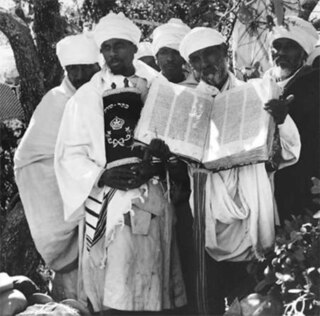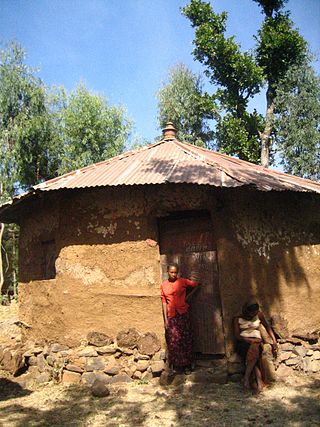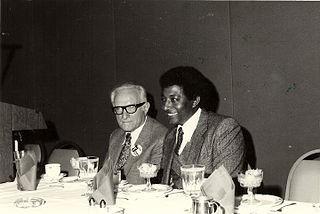Operation Moses was the covert evacuation of Ethiopian Jews from Sudan during a civil war that caused a famine in 1984. Originally called Gur Aryeh Yehuda by Israelis, the United Jewish Appeal changed the name to "Operation Moses".

African Jewish communities include:

The Beta Israel, or Ethiopian Jews, are an African community of the Jewish diaspora. They coalesced in the Kingdom of Aksum and the Ethiopian Empire, which is currently divided between the Amhara Region and Tigray Region in modern-day Ethiopia. After the founding of the State of Israel in 1948, most of the Beta Israel immigrated to Israel or were evacuated from Africa through several initiatives by the Israeli government.
Jewish ethnic divisions refer to many distinctive communities within the world's Jewish population. Although considered a self-identifying ethnicity, there are distinct ethnic subdivisions among Jews, most of which are primarily the result of geographic branching from an originating Israelite population, mixing with local communities, and subsequent independent evolutions.
The Qemant are a small Cushitic ethnic group in northwestern Ethiopia, specifically in Gondar, Amhara Region. The Qemant people traditionally practiced an early Pagan-Hebraic religion, however most members of the Qemant are followers of the Ethiopian Orthodox Church. They are historically related to, but distinct from, the Beta Israel.

Shlomo Moshe Amar is the former Sephardic Chief Rabbi of Israel. He served in the position of Rishon LeZion from 2003 to 2013; his Ashkenazi counterpart during his tenure was Yona Metzger. In 2014 he became the Sephardic Chief Rabbi of Jerusalem.
Qwara, or Qwareña, was one of two Agaw dialects, spoken by a subgroup of the Beta Israel of Qwara Province. It is a dialect of Qimant. It is nearly extinct. Several early Falashan manuscripts, using the Ge'ez script, exist; in more recent times, the language has been recorded by several linguists and travellers, starting with Flad in 1866.

Operation Solomon was a covert Israeli military operation from May 24 to 25, 1991, to airlift Ethiopian Jews to Israel. Non-stop flights of 35 Israeli aircraft, including Israeli Air Force C-130s and El Al Boeing 747s, transported 14,325 Ethiopian Jews to Israel in 36 hours. One of the aircraft, an El Al 747, carried at least 1,088 people, including two babies who were born on the flight, and holds the world record for the most passengers on an aircraft. Eight children were born during the airlift process.

Graenum Berger (1908–1999) was an American Communal administrator, institutional and communal planner, educator, world traveler, and the founding President of the American Association for Ethiopian Jews.
Sigd, also Mehlella or Amata Saww, is one of the unique holidays of the Beta Israel community, and is celebrated on the 29th of the Hebrew month of Marcheshvan. Since 2008, it has been an official Israeli state holiday.

Religion in Ethiopia consists of a number of faiths. Among these mainly Abrahamic religions, the most numerous is Christianity totaling at 67.3%, followed by Islam at 31.3%. There is also a longstanding but small Ethiopian Jewish community. Some adherents of the Baháʼí Faith likewise exist in a number of urban and rural areas. Additionally, there is also a substantial population of the adherents of traditional faiths.
Beta Abraham —other terms by which the community have been known include Tebiban, Balla Ejj, Buda and Kayla ,—is a community regarded by some as a crypto-Jewish offshoot of the Beta Israel community. The size of the community is estimated to be somewhere upwards of 150,000 in number.
Aliyah from Ethiopia is the immigration of the Beta Israel people to Israel. Early forms of Zionism have existed in Ethiopia since the mid 19th-century, as shown in the 1848 letters from the Beta Israel to Jews in Europe praying for the unification of Jews. A year after the first letter was sent, Daniel Ben Hananiah and his son were sent by the Kahen to Jerusalem and made contact with the Jewish leaders there.

The history of the Jews in Ethiopia refers to people in Ethiopia who practice Judaism or have Jewish ancestry. This history goes back millennia. The largest Jewish group in Ethiopia is the Beta Israel, also known as Ethiopian Jews. Offshoots of the Beta Israel include the Beta Abraham and the Falash Mura, Ethiopian Jews who were converted to Christianity, some of whom have reverted to Judaism. Addis Ababa is home to a small community of Adeni Jews. Chabad also maintains a presence in Addis Ababa.
Abba Saga was the son of the Ethiopian emperor Zara Yaqob, and a monk of Ethiopian Christianity. His teacher was Abba Sabra, a monk of Ethiopian Christianity. He rebelled against his father after his conversion to Judaism and took refuge in Hoharwa mountains with a Jewish monk named Abba Sabra. Later Abba Sabra and Abba Saga, established a separate kingdom in modern-day Ethiopia in which Jews were not persecuted, unlike the kingdom, of his father, who was known as "the exterminator of the Jews" in which Jews were severely persecuted. The two formed the Falasha form of monasticism on lines similar to those of the Christians.

The Kingdom of Simien, sometimes referred to as the Kingdom of Beta Israel, refers to a probably legendary Jewish kingdom said to have been located in the northwestern part of the Ethiopian Empire. The existence of such a kingdom somewhere in the Horn of Africa was first mentioned by the traveller Benjamin of Tudela in the 12th century CE.
Ethiopian Jews in Israel are immigrants and descendants of the immigrants from the Beta Israel communities in Ethiopia who now reside in Israel. To a lesser, but notable, extent, the Ethiopian Jewish community in Israel is also composed of Falash Mura, a community of Beta Israel which had converted to Christianity over the course of the past two centuries, but were permitted to immigrate to Israel upon returning to Israelite religion—this time largely to Rabbinic Judaism.

Henry Aaron Stern was an Anglican missionary and captive in Abyssinia.
Taamrat Emmanuel was a Jewish Ethiopian public figure, professor, rabbi and intellectual. One of the most prominent figures in the Beta Israel community in the Jewish Enlightenment movement and in the Early modern period.

Avraham Neguise is an Israeli politician and activist for the Falash Mura community. He served as a member of the Knesset for the Likud party from 2015 to 2019.












